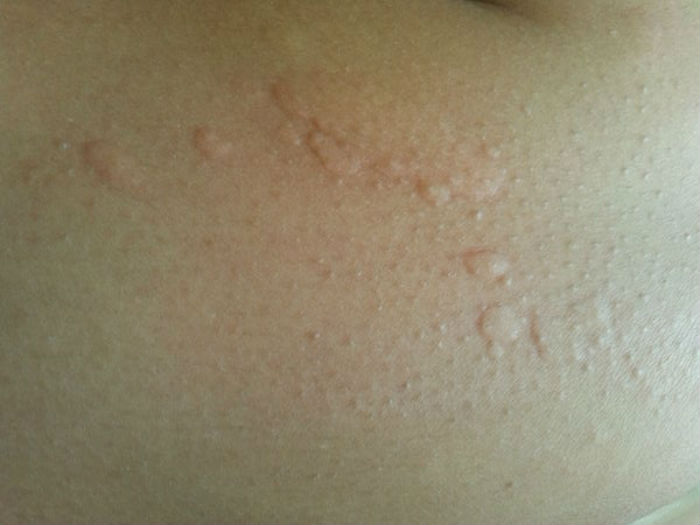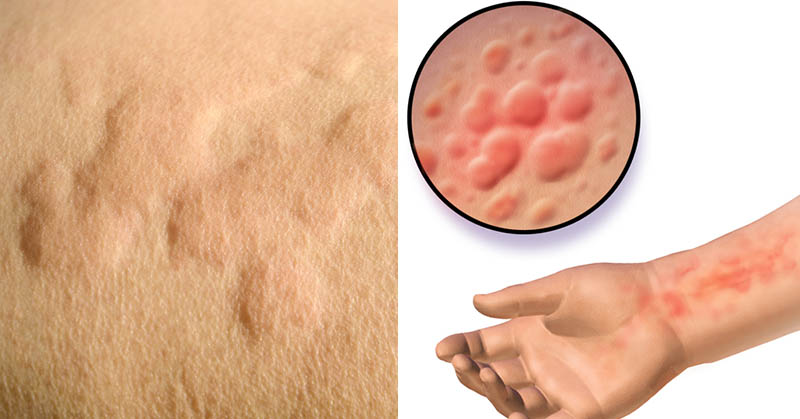Peanuts, gluten, pollen, bees… those are usually the first words that pop into people’s heads when they think of allergies. Well, the condition in question today is definitely one of the stranger ones we’ve covered. You’ll see why in a sec.
Have you ever come home from a brisk walk in the cold air, went swimming in cold water, or been drinking cold, refreshing H2O… only to noticed you’re having a strange, unexpected skin reaction? If you’re nodding your head in confused agreement, you might have what is called cold urticaria.
Is Cold Urticaria An Allergy?
Cold urticaria, which essentially translates to cold hives, is being allergic to cold. Cold anything – cold water, cold air, and cold objects. It occurs when your skin reacts – usually with hives – to exposure to cold temperatures.[1]
People who happen to be allergic to cold will often start experiencing a rash within the first five minutes exposure, which can last up to a couple of hours (or more).[2]
What Is the Cause of Cold Urticaria & Is It Rare?
Unfortunately, doctors and scientists are largely in the dark with regards to knowing the true cause of cold urticaria. Many of them do not believe it’s inherited because existing patients have no family history with the condition and most cases are irregular.
Researchers and medical professionals have linked the following health problems to people with cold urticaria:[2]
- Blood conditions
- Cryoglobulinemia
- Chronic lymphocytic leukemia
- Lymphosarcoma
- Chicken pox
- Vital hepatitis
- Mononucleosis
In addition to having any of the health conditions above, according to Mayo Clinic, being a young adult can also increase your chances of having or getting cold urticaria. When it comes to males and females, both populations are affected equally.[3]
What It’s Like Being Allergic to the Cold
24-year-old Cara Yacino from Douglas, Massachusetts is one of the affected population. Yacino received her cold urticaria diagnosis in June 2013 after a series of strange skin reactions that she could not for the life of her figure out… and it all started with holding a Dunkin Donuts iced mocha![4]
“I was holding [the mocha], and I realize my hand that was holding the iced mocha started swelling up and was really painful,” Yacino told weather.com. “It was kind of itchy, and it looked different (after) comparing my two hands.”
Initially, her mother thought that ingredients in the mocha were causing her daughter’s symptoms. Later that day, however, Yacino took a dip at Boston’s New England Aquarium.
“They had a touch tank — a shark and ray touch tank — and I stuck my arm in, like everyone else, so that the rays could swim by and touch my hand,” she said. “I was in the tank for maybe like 10 minutes. I pulled my arm out and within five minutes that arm was covered in hives.”
For Yacino, a recent fever had triggered an immune response that caused her cold urticaria. Unfortunately, many others never find out the specific cause.
Most Common Symptoms of Cold Urticaria

The symptoms of this skin condition will vary from person to person. While some suffer mild symptoms, others can experience quite severe reactions. However, the usual symptoms of cold urticaria may include:[1,2]
- Hives (i.e., reddish, itchy welts) on the area that suffered exposure to cold. Sometimes, the hives look and feel worse as the skin warms
- Swelling of hands (from touching or holding cold objects) and lips (from eating or drinking cold foods)
- Headaches
- Anxiety
- Fatigue
- Fainting
- Heart palpitations
- Wheezing
- Joint pain
- Low blood pressure
In more severe cases, exposure to cold can result in:
- Unconsciousness
- Shock
- Swelling of limbs or torso
- Swelling of tongue and throat (which can limit your ability to breathe)
- Death
How Do You Know If You Have Cold Urticaria?

If you want to know whether or not you have this form of physical urticaria, there’s an easy way to find out! All you need is an arm and an ice cube. Next, follow two steps:[5]
- Balance the ice cube on your forearm for 1-5 minutes
- After that time, if the exposed area of skin develops a swollen, reddish spreading rash, you could have cold urticaria
Are You Allergic to Cold? Here’s How to Treat Cold Urticaria
Luckily, both mild or severe reactions to physical urticaria will disappear on their own. And although the condition is currently incurable, there are steps people with cold urticaria can take to help prevent cold-induced outbreaks – naturally.
Your personal healthcare provider will likely suggest and prescribe over-the-counter antihistamines, prescription meds (e.g., Claritin, Clarinex, or Xolair), or an EpiPen.[1]
4 Natural Antihistamines to Help Prevent Symptoms of Cold Urticaria
If you can avoid putting synthetic medications into your body, we’re all for it! So, we hope that consuming these foods and plant extracts will help prevent future outbreaks.[6]
1) Bromelain
Remember our pineapple-infused water recipe? Another reason it’s so great is because of the compound it’s rich in – bromelain! Whether you get it from pineapple proper or in supplement form, researchers suggest that taking up to 1500 mg of bromelain every day can help relieve inflammation and respiratory distress.[7]
2) Vitamin C
This powerful vitamin swoops in to save the day again and again. The same researchers above who explored the benefits of bromelain also claim that ~2 grams of vitamin C daily will have the most effective antihistamine results.[7]
3) Stinging Nettle
Usually, you hear about stinging nettle for helping promote prostate health. However, researchers in one study found that participants who took 300 mg of this natural antihistamine every day reduced their allergy symptoms by 58 percent.[7]
4) Quercetin
It sounds like a prescription drug but you can actually find this powerful antioxidant in foods such as apples and onions. One study published in Inflammation Research found that quercetin lowered airway inflammation and other breathing problems.[8]
Related Disorders to Cold Urticaria
Growing your awareness of other health conditions that present similar symptoms can help you on your journey of prevention and treatment![3]
- Cold Agglutination Disease: This blood disorder occurs when your body’s blood temperature falls below 98.6°F (37°C).
- Raynaud’s Disease: When people with this disease experience exposure to cold, they suffer blood vessel spasms in their fingers and toes.
- Paroxysmal Cold Hemoglobinuria: In this disorder, tiny red blood bodies within cells are abnormally vulnerable to antibody attacks. Again, PCH is triggered by cold exposure.
We hope this article about cold urticaria helps your or someone you know! One of the worst feelings in the world is suffering and not knowing why. But if you’re allergic to cold, hopefully, this article helped shed some light on how to find some much-deserved relief.
Sources
- Cold urticaria. (2018, January 19). Retrieved from https://www.mayoclinic.org/diseases-conditions/cold-urticaria/symptoms-causes/syc-20371046
- Cold urticaria. (n.d.). Retrieved from https://rarediseases.info.nih.gov/diseases/6131/cold-urticaria
- Urticaria, Cold. (n.d.). Retrieved from https://rarediseases.org/rare-diseases/urticaria-cold/
- Allergic to the Cold: Living With Cold Urticaria. (2014, April 01). Retrieved from https://weather.com/health/allergy/news/allergic-cold-how-young-woman-fights-cold-urticaria-20140129
- Cold urticaria. (n.d.). Retrieved from https://www.dermnetnz.org/topics/cold-urticaria/
- The 4 Best Natural Antihistamines. (n.d.). Retrieved from https://www.healthline.com/health/allergies/best-natural-antihistamines
- Thornhill, S. M., & Kelly, A. M. (2000, October). Natural treatment of perennial allergic rhinitis. Retrieved from https://www.ncbi.nlm.nih.gov/pubmed/11056414
- Rogerio, A. P., Kanashiro, A., Fontanari, C., Da, E. V., Lucisano-Valim, Y. M., Soares, E. G., & Faccioli, L. H. (2007, October). Anti-inflammatory activity of quercetin and isoquercitrin in experimental murine allergic asthma. Retrieved from https://www.ncbi.nlm.nih.gov/pubmed/18026696
- Image Sources:
- https://www.dermnetnz.org/topics/cold-urticaria/
- https://it.wikipedia.org/wiki/File:Cold_urticaria3.jpg

